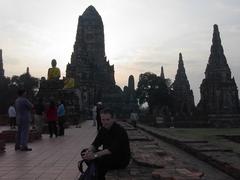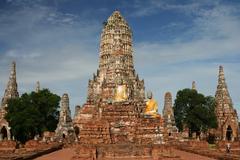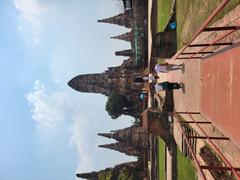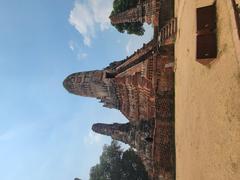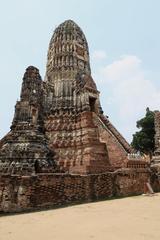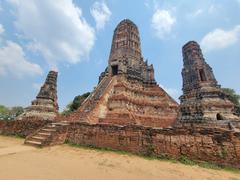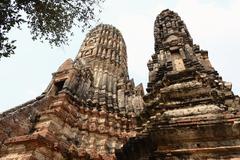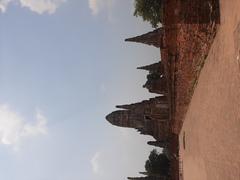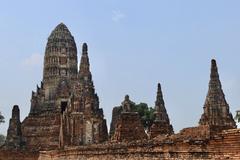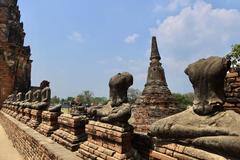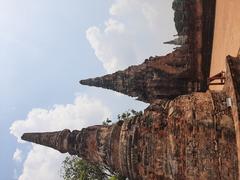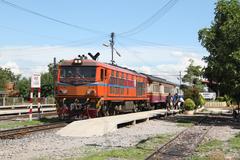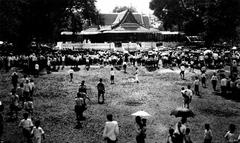
Wat Chaiwatthanaram Visiting Hours, Tickets, and Travel Guide in Phra Nakhon Si Ayutthaya
Date: 14/06/2025
Introduction
Wat Chaiwatthanaram, one of Ayutthaya’s most striking and historically significant temples, stands as a testament to the artistic brilliance and spiritual legacy of the former Siamese capital. Built in 1630 by King Prasat Thong, the temple reflects the grandeur of the Ayutthaya Kingdom, blending Khmer architectural influences with deep-rooted Buddhist symbolism. Today, it is a UNESCO World Heritage Site, renowned for its central prang, riverside setting on the Chao Phraya River, and role as both a cultural landmark and a venue for religious festivals. This comprehensive guide covers everything you need to know about Wat Chaiwatthanaram: visiting hours, ticket prices, accessibility, historical context, architectural details, travel tips, and nearby attractions. Whether you are a history enthusiast, spiritual seeker, or casual traveler, this guide will help you make the most of your visit to this iconic site (Renown Travel; thaiunikatravel.com; Tourist Platform).
Contents
- Historical Background
- Architectural Features
- Cultural and Spiritual Significance
- Practical Visitor Information
- Travel Tips and Nearby Attractions
- Frequently Asked Questions (FAQ)
- Conclusion and Recommendations
- Sources and Further Reading
Historical Background
Origins and Founding
Wat Chaiwatthanaram was commissioned in 1630 by King Prasat Thong to honor his mother and reinforce his legitimacy as ruler. The temple’s name, meaning “Temple of Long Reign and Glorious Era,” encapsulates the king’s aspirations for both personal merit and the enduring prosperity of Ayutthaya (Renown Travel; Go Find Orient). The ashes of the king’s mother were enshrined within two chedis near the ordination hall, further cementing the site’s significance as a royal and filial monument.
Architectural Significance
The temple’s design draws heavily on Khmer influences, modeled after the mountain temples of Angkor. The towering 35-meter central prang, surrounded by eight chedis, forms a symbolic representation of Mount Meru—central to Hindu and Buddhist cosmology. The east-west orientation, with the main entrance facing the Chao Phraya River, highlights both ritual significance and practical access for royal arrivals (Asia Travel Information).
Destruction and Restoration
Wat Chaiwatthanaram was severely damaged during the Burmese invasion of 1767, after serving as a defensive stronghold. Following centuries of neglect, restoration efforts led by the Fine Arts Department in the late 20th century stabilized the structure and preserved surviving décor (Renown Travel). The temple is now a key highlight of the Ayutthaya Historical Park and an enduring emblem of Thai heritage.
Architectural Features
Central Prang and Layout
- The 35-meter central prang is the visual and symbolic core, representing Mount Meru.
- Four smaller prangs at each platform corner reinforce the temple’s cosmological symbolism.
- Eight chedis are symmetrically arranged around the platform, originally housing Buddha images and relics (thaiunikatravel.com).
Galleries and Decorative Elements
- A cloister, or gallery, once housed up to 120 lacquered and gilded Buddha statues. Many were lost or damaged during past conflicts, but the remaining statues and their arrangement still evoke the temple’s historic grandeur (guide2thailand.com).
- Stucco reliefs and floral motifs, though weathered by time, display the refined artistry of the Ayutthaya period.
Khmer Influence
Wat Chaiwatthanaram’s overall symmetry, prang-centered layout, and use of decorative stucco exemplify the intersection of Khmer and local Ayutthayan styles (topasiatour.com; amazingthailand.org).
Enclosure and Entrances
- The temple is encircled by a substantial wall with arched gateways, the main one facing east for royal riverine arrivals (amazingthailand.org).
- Construction materials include red brick and stucco, both practical and decorative.
Restoration
Modern restoration efforts have preserved the main structures, stabilized the foundation, and improved visitor access while maintaining the temple’s historical integrity (thai-hub.com; holidify.com).
Cultural and Spiritual Significance
Royal and Buddhist Symbolism
Wat Chaiwatthanaram was conceived as both a royal monument and a hub of Theravada Buddhist practice. The central prang symbolizes the universe’s axis, while the chedis represent the continents and oceans of Buddhist cosmology (Tourist Platform). The temple’s layout and iconography reflect the king’s role as a universal ruler and merit-maker.
Monastic and Ritual Life
The temple was historically a center for monastic education, meditation, and public religious ceremonies. Its galleries were adorned with murals and Buddha images, used for teaching Buddhist stories and moral values (Travel Triangle).
Cultural Festivals
Wat Chaiwatthanaram remains a focal point for Buddhist festivals such as Loy Krathong, Visakha Bucha, and the Ayutthaya World Heritage Fair, when the temple is illuminated and hosts communal rituals and cultural performances.
Community Engagement
Local communities play a vital role in the temple’s preservation, participating in clean-up efforts, fundraising, and organizing cultural events (Tourist Platform).
Visitor Etiquette
- Dress modestly (shoulders and knees covered)
- Remove shoes when entering sacred areas
- Refrain from climbing on ruins or touching Buddha images
- Respect the quiet, spiritual atmosphere (Asia Highlights)
Practical Visitor Information
Location
Ban Pom, Phra Nakhon Si Ayutthaya, on the west bank of the Chao Phraya River, approximately 8 kilometers west of central Ayutthaya.
Visiting Hours
- Open daily: 8:00 AM – 6:00 PM
- Some sources may list slightly different opening times (e.g., 8:30 AM – 5:30 PM); always check official updates before visiting.
Tickets and Admission
- Foreign visitors: 50 THB
- Discounts for Thai nationals, children under 15, and students
- Tickets are available at the entrance (cash only); combined tickets for multiple sites in Ayutthaya Historical Park are also available (Tourism Authority of Thailand)
Getting There
- From Ayutthaya: Tuk-tuk, taxi, bicycle, or boat from the city center or pier (runawayann.com)
- From Bangkok: Train (1.5–2 hours), bus (2–3 hours), or private vehicle; then local transport to the temple
Accessibility
- Mostly flat but with uneven brick paths and steps—limited wheelchair access
- Rest areas and basic facilities are available
On-Site Amenities
- Restrooms and refreshment vendors near the entrance
- Bicycle and car parking
- Traditional Thai costume rentals for photos (approx. 50 THB)
- Café and riverside relaxation areas (trip.com)
Travel Tips and Nearby Attractions
Best Time to Visit
- Cool, dry season: November–February is most comfortable, with pleasant temperatures
- Sunrise and sunset: Offer the best lighting for photography and a tranquil atmosphere
What to Bring
- Sun protection: hat, sunscreen, sunglasses
- Water bottle
- Comfortable shoes
- Camera
- Cash for entrance fees and snacks
Guided Tours
Available at the temple entrance or via local agencies, providing deeper insights into history and culture. Audio guides may also be offered.
Nearby Attractions
- Wat Mahathat
- Wat Phra Si Sanphet
- Wat Lokayasutharam
- Ayutthaya Historical Park
Renting a bicycle or hiring a tuk-tuk is a popular way to visit several sites in one day.
Frequently Asked Questions (FAQ)
Q: What are the visiting hours?
A: Typically 8:00 AM to 6:00 PM daily, but verify with the official website before your visit.
Q: How much is the entrance fee?
A: 50 THB for foreign adults; discounts for Thai nationals, students, and children.
Q: Is the temple suitable for children?
A: Yes, but supervise children due to uneven terrain and historical ruins.
Q: Can I take photos or use drones?
A: Photography is allowed; drone use is generally restricted and requires permission.
Q: Are pets allowed?
A: No, pets are not permitted on temple grounds.
Q: Is Wat Chaiwatthanaram accessible for visitors with disabilities?
A: Access is limited due to uneven ground and steps; assistance is recommended.
Conclusion and Recommendations
Wat Chaiwatthanaram captures the spirit of Thailand’s royal, religious, and artistic heritage. Its riverside setting, grand Khmer-inspired architecture, and peaceful atmosphere make it a must-visit landmark in Ayutthaya. For the best experience, plan your visit during the cool season, arrive early or late in the day for optimal lighting, and dress respectfully. Consider pairing your visit with other nearby historical sites, and engage with local guides or community events for a deeper understanding of Ayutthaya’s legacy.
For official updates, tickets, and further information, consult the Ayutthaya Historical Park Official Website and the Tourism Authority of Thailand. Download the Audiala app for offline maps, guided tours, and the latest travel tips. Join fellow travelers in discovering the timeless grandeur of Wat Chaiwatthanaram and the wonders of Ayutthaya.
Sources and Further Reading
- Wat Chaiwatthanaram Visiting Hours, Tickets, and History: A Guide to Ayutthaya’s Iconic Temple, 2024
- Wat Chaiwatthanaram Visiting Hours, Tickets & Guide to Ayutthaya’s Historic Temple, 2024
- Wat Chaiwatthanaram Visiting Hours, Tickets, and Cultural Significance in Ayutthaya, 2024
- Wat Chaiwatthanaram Visiting Hours, Tickets, and Visitor Guide to Ayutthaya Historical Site, 2024
- Wat Chaiwatthanaram - Asia Travel Information, 2024
- Wat Chaiwatthanaram - Travel Triangle, 2024
- Ayutthaya Historical Park Official Website, 2024
- Tourism Authority of Thailand, 2024
